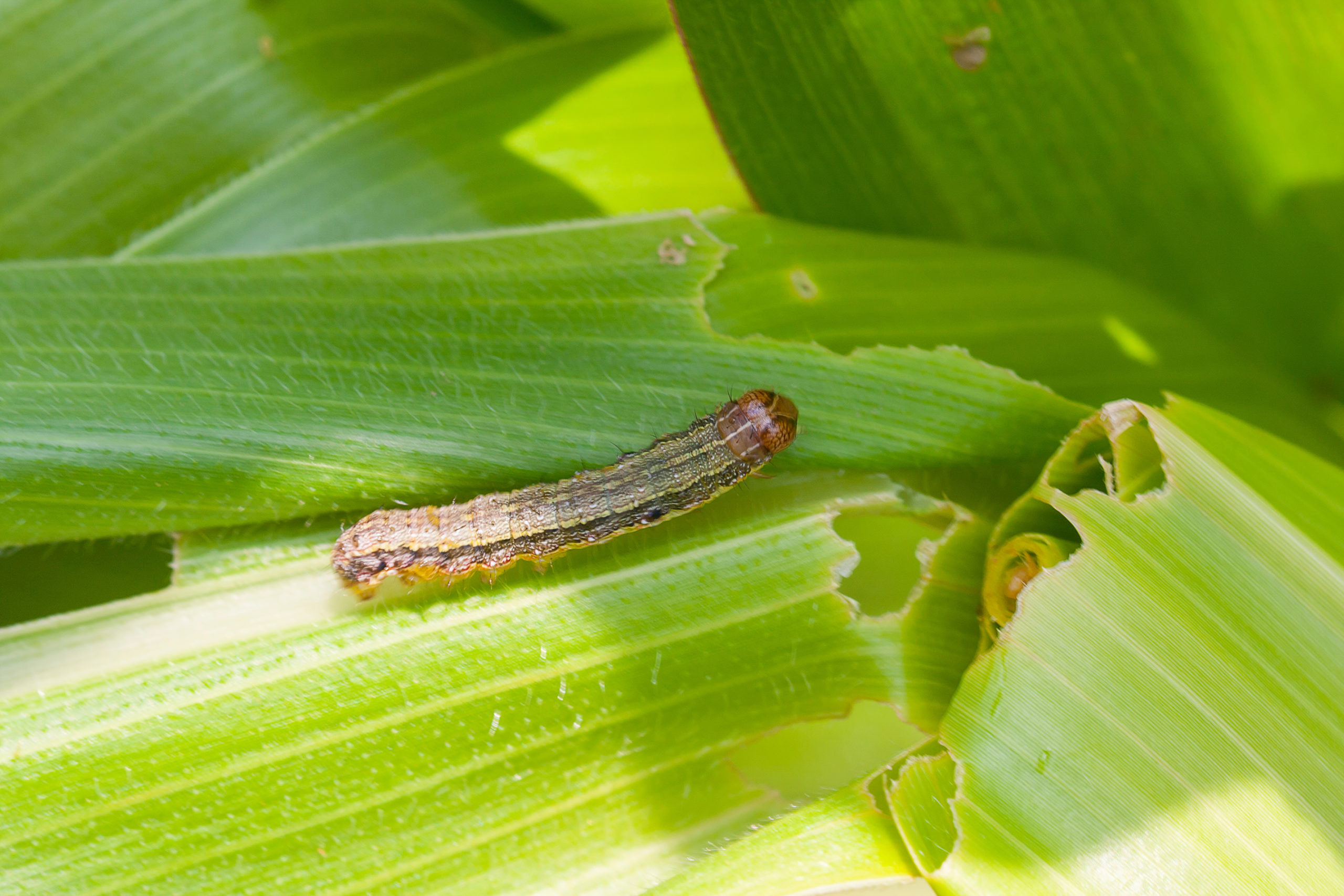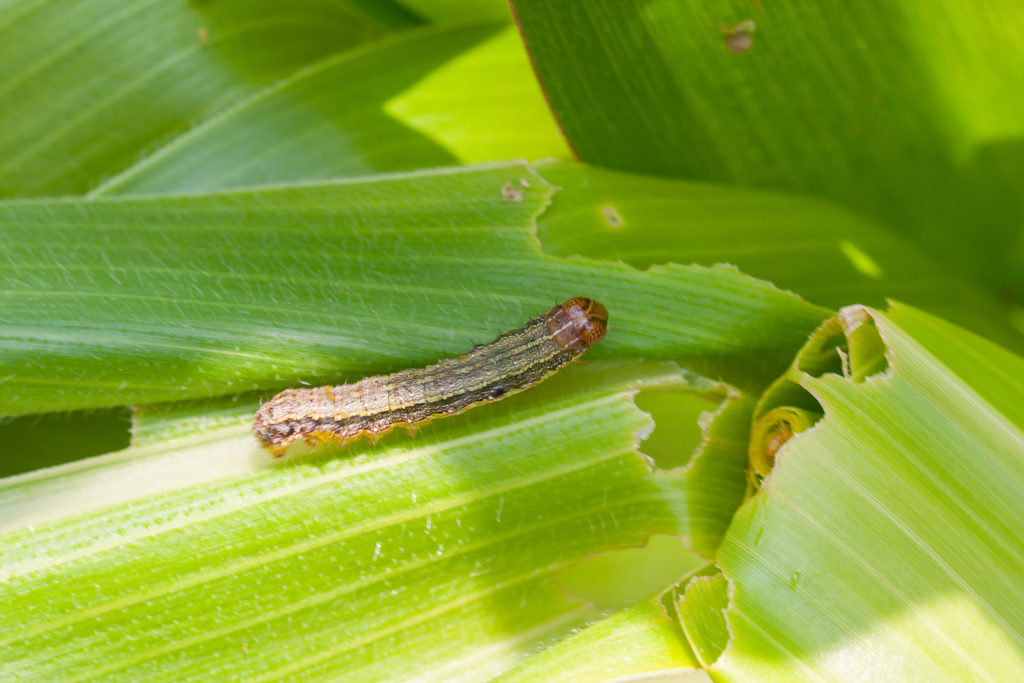
Armyworm caterpillars are the larvae of small ash-gray moths. While there are several species of armyworms, the type that can impact Texas Longhorn cattle the most is fall armyworms. They emerge in late summer and early fall and they plague agricultural crops, small grains, grass, and green pastures. The complete defoliation caused by severe infestation weakens plants and deprives livestock of pasture, making these destructive pests detrimental to cattlemen. Below, we at Star Creek Ranch have broken down everything you need to know about fall armyworms.
Fall armyworms get their name because they appear to march across forage crops, devouring them as they go. People with large infestations actually report that they can hear them munching on the grass! They can easily go undetected at first because they are most active in the evening, at night, and in the early hours of the morning and crawl into silk-lined burrows during the day. Usually, you will notice their presence by your forage crops seemingly disappearing overnight.
What Do Fall Armyworms Look Like?
Fall armyworms begin as small green caterpillars with brown or black heads. As they consume grass over the course of about two weeks and grow, their bodies darken and they develop noticeable stripes along the middle of their backs–a yellowish-gray band and a dark, black stripe beneath it. The most prominent identifier is the white inverted Y on their heads. The adult fall armyworm is an ash-gray moth with a wingspan between an inch and an inch and a half.
 Fall Armyworm Life Cycle
Fall Armyworm Life Cycle
Fall armyworm eggs are creamy-white and dome-shaped with a flat base. Female moths can lay up to 2,000 eggs, usually in batches of 25-100 eggs. Moths prefer to lay their egg clusters on light-colored surfaces, such as grass blades, tree limbs, fence rails, etc. and eggs hatch a few days later. Female fall armyworms develop from an egg, mature, transform into a moth, and begin to lay their own eggs over the course of about 28 days. Several generations occur each year and populations grow quite rapidly throughout the summer and into fall–that’s why they can cause so much damage.
How To Know If You Have Fall Armyworms
Fall armyworm damage commonly occurs from August through October when populations are at seasonal highs. Heavy rain promotes the growth of pasture and wild grasses that fall armyworms develop on, so large population outbreaks typically occur shortly after rain.
Some signs to look out for that may indicate that your hayfields and pastures have a fall armyworm infestation are:
- Virtually all tender green grass is gone and you are left with only tough stems a few inches long
- Rapidly increasing dead/brown patches in the field
- The presence of larvae feces in the field, known as frass (may look like tiny green-yellow pellets)
- Cattle egrets and/or geese are feeding in concentrated areas
- Foliage is chewed only on the underside
You should also pay attention to the condition of your neighboring fields because this pest can invade an area once an adjacent field has been devoured.
Fall Armyworm Control
Early detection of fall armyworms is the best way to manage outbreaks and prevent them from causing much damage. Preventive treatments should be started at the first sight of army worms or damage. There are several chemicals that can be sprayed on fields to kill the armyworms.
Scouting
Scouting your pastures and fields thoroughly and frequently can help you catch an infestation early. Use an insect net to sweep the forage grass (in the early morning or late afternoon) and count the number of armyworms you find in a square foot area.
If you don’t have a sweep net, inspect areas with dead grass or where birds are congregating. If you don’t see any caterpillars on the grass, look in the thatch at the base of the plants for larvae and their feces (frass). Additionally, look to see if caterpillars are stuck on the tires of vehicles that have been driven through wet fields.
There are insecticides that are labeled for pastures and hayfields that can be used for treatment.
Tips for using insecticide for fall armyworms:
- Read the label carefully to make sure that the insecticide can be applied to a particular type of forage.
- Ensure you take any precautions instructed on the label, such as any grazing or haying restrictions.
- Follow the mixing instructions–never apply the insecticide in less water than the label recommends.
- Apply insecticides early or late in the day when fall armyworm larvae are most active.
- Use as large a spray volume as you can.
- Scout for armyworms because you may not have to treat the entire field or multiple fields.
- Small fall armyworms are much easier to kill than larger ones, and some products will not control large larvae at all. Try to find the caterpillars when they are small so you can save money by using a lower rate of insecticide.
- Apply insecticides where you find the caterpillars.
You may be able to avoid using an insecticide by mowing frequently and quickly raking and baling hay. If you have a large infestation, harvesting alone may not be enough to stop the armyworms.
If fall armyworms have already damaged your fields, closely monitor them for the rest of the season to determine whether they need further treatment. Heavily damaged fields may be fertilized to allow for another hay crop, whereas severely damaged pastures may need to be rested (if possible, restrict grazing on severely damaged pastures until grass regrows).
Fall armyworms can be devastating to pastures and Texas Longhorn cattle. To learn more, contact me, Darlene, at Star Creek Ranch today. I love to “Talk Texas Longhorns” and will be glad to help in any way I can.

